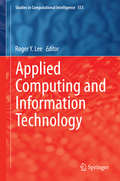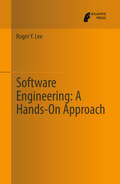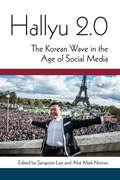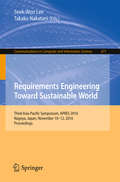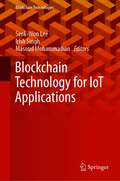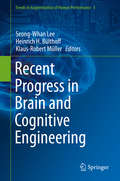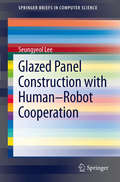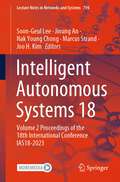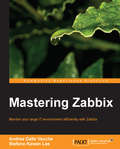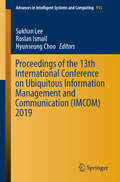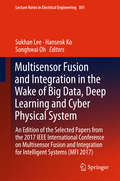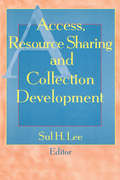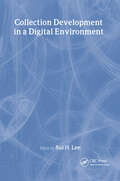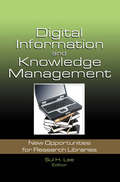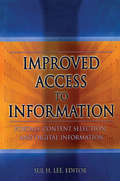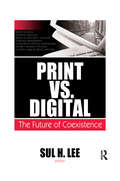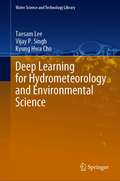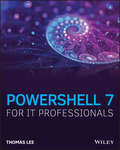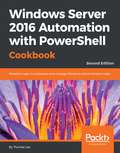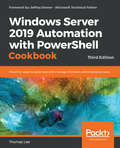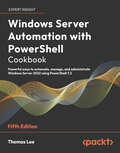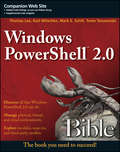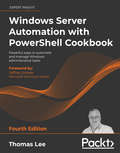- Table View
- List View
Applied Computing and Information Technology (Studies in Computational Intelligence #553)
by Roger Y. LeeThis book presents the selected results of the 1st International Symposium on Applied Computers and Information Technology (ACIT 2013) held on August 31 - September 4, 2013 in Matsue City, Japan, which brought together researchers, scientists, engineers, industry practitioners and students to discuss all aspects of Applied Computers & Information Technology and its practical challenges. This book includes the best 12 papers presented at the conference, which were chosen based on review scores submitted by members of the program committee and underwent further rigorous rounds of review.
Software Engineering: A Hands-On Approach
by Roger Y. LeeThis textbook provides a progressive approach to the teaching of software engineering. First, readers are introduced to the core concepts of the object-oriented methodology, which is used throughout the book to act as the foundation for software engineering and programming practices, and partly for the software engineering process itself. Then, the processes involved in software engineering are explained in more detail, especially methods and their applications in design, implementation, testing, and measurement, as they relate to software engineering projects. At last, readers are given the chance to practice these concepts by applying commonly used skills and tasks to a hands-on project. The impact of such a format is the potential for quicker and deeper understanding. Readers will master concepts and skills at the most basic levels before continuing to expand on and apply these lessons in later chapters.
Drawing Amanda: Enhanced Edition
by S. Y. Lee Stephanie FeuerIn this enhanced edition of DRAWING AMANDA, the illustrations come to life through animations -- as if Inky, the main character, is drawing them as you watch. DRAWING AMANDA is set in the under-parented, high-expectation adolescent world of a Manhattan international prep school. Fourteen-year-old budding artist Inky Kahn is still smarting from the death of his father. He thinks he's found his big break when he bonds with the developer of a new computer game and snags a coveted drawing assignment, for which he uses his secret crush-Amanda-as a model. But unbeknownst to Inky, the developer has a dangerous criminal past, and is using his computer game to lure and stalk teenage girls. And Inky has inadvertently led Amanda right into his path. Blinded by his own ambition and sulking from his father's death, Inky hides from the truth. Will Inky, with the help of Rungs, his cybergeek pal, discover the crime in time and save Amanda before the creep ensnares her-or anyone else?
Drawing Amanda: Enhanced
by S. Y. Lee Stephanie FeuerDRAWING AMANDA is set in the under-parented, high-expectation adolescent world of a Manhattan international prep school. Fourteen-year-old budding artist Inky Kahn is still smarting from the death of his father. He thinks he's found his big break when he bonds with the developer of a new computer game and snags a coveted drawing assignment, for which he uses his secret crush-Amanda-as a model. But unbeknownst to Inky, the developer has a dangerous criminal past, and is using his computer game to lure and stalk teenage girls. And Inky has inadvertently led Amanda right into his path. Blinded by his own ambition and sulking from his father's death, Inky hides from the truth. Will Inky, with the help of Rungs, his cybergeek pal, discover the crime in time and save Amanda before the creep ensnares her-or anyone else?
Hallyu 2. 0: The Korean Wave In The Age Of Social Media
by Sangjoon Lee Abé Markus NornesCollectively known as Hallyu, Korean music, television programs, films, online games, and comics enjoy global popularity, thanks to new communication technologies. In recent years, Korean popular culture has also become the subject of academic inquiry. Whereas the Hallyu's impact on Korea's national image and domestic economy, as well as on transnational cultural flows, have received much scholarly attention, there has been little discussion of the role of social media in Hallyu's propagation. Contributors to Hallyu 2. 0: The Korean Wave in the Age of Social Media explore the ways in which Korean popular cultural products are shared by audiences around the globe; how they generate new fans, markets, and consumers through social media networks; and how scholars can analyze, interpret, and envision the future of this unprecedented cultural phenomenon.
Requirements Engineering Toward Sustainable World
by Seok-Won Lee Takako NakataniThis book constitutes the proceedings of the Third Asia Pacific Requirements Engineering Symposium, APRES 2016, held in Nagoya, Japan, in November 2016.The 7 full papers presented together with three short papers, were carefully reviewed and selected from 14 submissions. The papers are organized in topical sections on requirements traceability and prioritization; requirements modeling and process for quality; requirements validation; requirements analysis.
Blockchain Technology for IoT Applications (Blockchain Technologies)
by Seok-Won Lee Irish Singh Masoud MohammadianThis book explores recent advances in the Internet of things (IoT) via advanced technologies and provides an overview of most aspects which are relevant for advance secure, distributed, decentralized blockchain technology in the Internet of things, their applications, and industry IoT. The book provides an in-depth analysis of the step-by-step evolution of IoT to create a change by enhancing the productivity of industries. It introduces how connected things, data, and their communication (data sharing) environment build a transparent, reliable, secure environment for people, processes, systems, and services with the help of blockchain technology.
Recent Progress in Brain and Cognitive Engineering
by Seong-Whan Lee Heinrich H. Bülthoff Klaus-Robert MüllerFor 'Recent Progress in Brain and Cognitive Engineering' Brain and Cognitive Engineering is a converging study field to derive a better understanding of cognitive information processing in the human brain, to develop "human-like" and neuromorphic artificial intelligent systems and to help predict and analyze brain-related diseases. The key concept of Brain and Cognitive Engineering is to understand the Brain, to interface the Brain, and to engineer the Brain. It could help us to understand the structure and the key principles of high-order information processing on how the brain works, to develop interface technologies between a brain and external devices and to develop artificial systems that can ultimately mimic human brain functions. The convergence of behavioral, neuroscience and engineering research could lead us to advance health informatics and personal learning, to enhance virtual reality and healthcare systems, and to "reverse engineer" some brain functions and build cognitive robots. In this book, four different recent research directions are presented: Non-invasive Brain-Computer Interfaces, Cognitive- and Neural-rehabilitation Engineering, Big Data Neurocomputing, Early Diagnosis and Prediction of Neural Diseases. We cover numerous topics ranging from smart vehicles and online EEG analysis, neuroimaging for Brain-Computer Interfaces, memory implantation and rehabilitation, big data computing in cultural aspects and cybernetics to brain disorder detection. Hopefully this will provide a valuable reference for researchers in medicine, biomedical engineering, in industry and academia for their further investigations and be inspiring to those who seek the foundations to improve techniques and understanding of the Brain and Cognitive Engineering research field.
Glazed Panel Construction with Human-Robot Cooperation
by Seungyeol LeeThese days, construction companies are beginning to be concerned about a potential labor shortage by demographic changes and an aging construction work force. Also, an improvement in construction safety could not only reduce accidents but also decrease the cost of the construction, and is therefore one of the imperative goals of the construction industry. These challenges correspond to the potential for Automation and Robotics in Construction as one of solutions. Almost half of construction work is said to be material handling and materials used for construction are heavy and bulky for humans. To date, various types of robots have been developed for glazed panel construction. Through the case studies on construction, to which the robots were applied, however, we identified difficulties to be overcome. In this study, a human-robot cooperative system is deduced as one approach to surmount these difficulties; then, considerations on interactions among the operator, robot and environment are applied to design of the system controller. The human-robot cooperative system can cope with various and construction environments through real-time interaction with a human, robot and construction environment simultaneously. The physical power of a robot system helps a human to handle heavy construction materials with a relatively scaled-down load. Also, a human can feel and respond to the force reflected from robot end effecter acting with working environment. Through the experiments and mock-up tests with a prototype robot, we observe the characteristics of the power assist and the force reflection, the merits of the human-robot cooperation system. To apply human-robot cooperative system at real construction sites, Glazed Ceiling Panel Construction Robot is developed for the first time. This robot is distinguished from other glazed panel construction robots because of the methods of lifting the panel to high installation positions and installing the fragile and bulk panel with robot force control. After applying to real construction sites, evaluation on the productivity of the developed robot was done by comparing and analyzing with the existing installation methods.
Intelligent Autonomous Systems 18: Volume 2 Proceedings of the 18th International Conference IAS18-2023 (Lecture Notes in Networks and Systems #794)
by Soon-Geul Lee Jinung An Nak Young Chong Marcus Strand Joo H. KimIntelligent autonomous systems are increasingly being applied in various fields, ranging from industrial applications to professional services and household domains. These advancements in technology and application domains have brought forth the need for continuous research and development to address new challenges in deploying intelligent autonomous systems in a reliable and user-independent manner This book is a compilation that aims to serve researchers and practitioners in related fields by providing a timely dissemination of recent progress in the areas of autonomous mobility and robotics. The contents of this book are based on a collection of papers presented at the 18th International Conference on Intelligent Autonomous Systems (IAS18 2023), held at the Suwon Convention Center in Suwon, Korea. The conference took place fully in person from July 4 to 7, 2023, with the theme “Impact and Effect of AI on Intelligent Autonomous Systems.” It encompassed discussions on theories, applications, and creative innovations in intelligent autonomous systems, covering topics such as autonomous vehicles, intelligent agents, smart sensors and actuators, smart haptics, human–machine interaction, digital twin, digital health, and metaverse, VR, AR, or MR. For ease of reading, the 91 papers have been grouped into five chapters: Chapter 1: Intelligent Autonomous Vehicles; Chapter 2: Autonomous Robots; Chapter 3: Intelligent Perception and Sensors; Chapter 4: Data Fusion and Machine Learning for Intelligent Robots; and Chapter 5: Applied Autonomous Systems. The articles included in this book underwent a rigorous peer-review process and were presented at the IAS18-2023 conference. For researchers working in the field of intelligent autonomous systems technology, we believe this book provides valuable insights into recent advances in autonomous technologies and applications, thereby enriching their studies. We extend our heartfeltthanks to all the authors and editors who contributed to this edition.
Mastering Zabbix
by Stefano Kewan Lee Andrea Dalle VaccheWritten as a practical step-by-step tutorial, this book is full of engaging examples to help you learn in a practical context.If you are a system administrator or an IT architect and want to know how to better integrate your Zabbix installation with your surrounding environment, this book is ideal for you. A basic, working knowledge of Zabbix is assumed, so that the book can focus on how to take full advantage of every component. The code in the later chapter will be explained in its functionality, but basic programming skills are assumed as well.
Proceedings of the 13th International Conference on Ubiquitous Information Management and Communication (Advances in Intelligent Systems and Computing #935)
by Sukhan Lee Roslan Ismail Hyunseung ChooOver past few years, technologies have experienced boundaries getting blurred and concept of convergence to gain prominence. Harnessing from this, two main tracks for information processing management and communication are held, covering both research and application works of information management, intelligent information processing, interaction management, networking/ telecommunications, and social interaction. This book creates unique opportunity for research convergence among truly diverse technology domains of computer science. Leveraging from this diversity of topics, researchers get to generate novel research ideas by seeking application of their research in a different technology domain. This volume represents the collection of papers presented at the 13th International Conference on Ubiquitous Information Management and Communication (IMCOM 2019), held on 4-6 January 2019 in Phuket, Thailand. Out of 228 papers submitted from all around the world 88 papers were accepted for presentations. The 88 contributions to this volume are organized into 5 chapters: Chapter 1. Network Evolution, Chapter 2. Intelligent and Secure Network, Chapter 3. Image and Video Processing, Chapter 4. Information Technology and Society, and Chapter 5. Data Mining and Learning. Our editors wish readers to find this volume informative and enjoyable.
Multisensor Fusion and Integration in the Wake of Big Data, Deep Learning and Cyber Physical System: An Edition of the Selected Papers from the 2017 IEEE International Conference on Multisensor Fusion and Integration for Intelligent Systems (MFI 2017) (Lecture Notes in Electrical Engineering #501)
by Sukhan Lee Hanseok Ko Songhwai OhThis book includes selected papers from the 13th IEEE International Conference on Multisensor Integration and Fusion for Intelligent Systems (MFI 2017) held in Daegu, Korea, November 16–22, 2017. It covers various topics, including sensor/actuator networks, distributed and cloud architectures, bio-inspired systems and evolutionary approaches, methods of cognitive sensor fusion, Bayesian approaches, fuzzy systems and neural networks, biomedical applications, autonomous land, sea and air vehicles, localization, tracking, SLAM, 3D perception, manipulation with multifinger hands, robotics, micro/nano systems, information fusion and sensors, and multimodal integration in HCI and HRI. The book is intended for robotics scientists, data and information fusion scientists, researchers and professionals at universities, research institutes and laboratories.
Access, Resource Sharing and Collection Development
by Sul H LeeAccess, Resource Sharing, and Collection Development explores the role of libraries in acquiring, storing, and disseminating information in different formats to help you better use technology to share scarce resources and connect library users with collections. With an expressed goal of encouraging continued debate and further investigation, this book provides you with developing strategies and procedures to meet the challenges you face as a collection development librarian during this dynamic time. Among the vital concerns addressed are the competition for limited resources, trends in document delivery, the evaluation of document delivery products, and libraries’options for the future.The chapters collected in Access, Resource Sharing, and Collection Development represent the proceedings of the annual conference held by the University of Oklahoma Libraries and the University of Oklahoma Foundation. The book provides insight into your peers’findings and ideas on: access vs. ownership the future role of the bibliographer changes in collection management managing restrained resource budgets an emphasis on the library user as customer the growth and acceptance of document delivery as a component of collection development and ILL electronic publishing and copyright issues commercial document delivery services Access, Resource Sharing, and Collection Development also shows you how to discover and evaluate "free" resources on the Internet, as standards for production, promotion, and maintenance are nonexistent. The challenge of using these materials is being met by developing criteria for selection, looking at cataloging options, and working in cooperation with other institutions. You’ll also learn the different options for document delivery and how to evaluate document delivery products. Among the book’s advice: you should consider the types of document delivery available, examine the benefits of combining outside services with in-house systems, review the criteria for selecting technologies and suppliers, and explore examples of institutions creating customized systems.
Collection Development in a Digital Environment: Shifting Priorities
by Sul H LeeLibrarians and other library professionals will find this informative book chock full of thought-provoking papers that will help you find new solutions to the collection development problems your library may experience while facing this new digital age. Collection Development in a Digital Environment is a result of papers presented at the 1998 University of Oklahoma Libraries Conference. You will discover ways to help your library take the lead in advancing the academic agenda through technology while at the same time leaning how technology requires change in the way libraries themselves operate. Collection Development in a Digital Environment explores ethical and technological dilemmas of collection development and gives several suggestions on how your library can successfully deal with these challenges and provide patrons with the information they need.This guide covers many valuable ways that your library can be better prepared for developing a “user friendly” collection of materials in this new digital age. You will discover how methods to shift your library from buying materials for collections for faculty or students that may need them sporadically to a system of responsiveness and customization where “just in time” and “just for you” are the standards of information access, making you and your library both time-effective and cost-effective. Collection Development in a Digital Environment brings to light many ways in which libraries can improve collection development methods, such as:using the Association of Research Libraries (ARL) initiatives to improve global access to information, such as the Global Resources Program, which features a seamless web of interconnected, coordinated, and interdependent research collections that are electronically accessible to usersexamining discussions on scenario-driven planning and the benefits of having your patrons let you know what they are interested in instead of guessing what materials they may be interested inanalyzing the influence of the World Wide Web on the role of libraries to discover how you can use these ideas to expand the collection of materials in your librarygaining insight into how the concept of disintermediation in the publishing process will help libraries use the electronic environment to eliminate intermediate sources and collect materials directly from the publisher, thus saving time and moneyFrom the insightful chapters in Collection Development in a Digital Environment, you will find new and successful ways to use the new digital environment to enhance collection development in your library. This unique book will help your library be more digitally accessible while still being user-friendly to your clientele.
Digital Information and Knowledge Management: New Opportunities for Research Libraries
by Sul H. LeeDigital Information and Knowledge Management examines how academic librarians can use knowledge management to provide an increasing amount of electronic information to an expanding user base. Several of the country’s leading library administrators analyze these vital issues from the perspectives of both information providers and library users, exploring the challenges of selecting and managing electronic information and resources, making the most of knowledge management, and improving digital access to their users. Electronic resources have given the library new roles to fill and created a demand for librarians skilled in the acquisition, retrieval, and dissemination of digital information. Libraries and librarians have met the challenges presented by digital resources and have moved from building collections of print materials into the growing field of knowledge management. Digital Information and Knowledge Management offers insights into how librarians are making that transition to enhance the resources and services they can offer library users. Topics examined in Digital Information and Knowledge Management include: cooperative collection development the balance of print and electronic resources the evolution of digital resources in libraries the concept of knowledge management changes in research libraries knowledge management in academic libraries factors that influence the selection of electronic resources disseminating information about scholarly collections the need for a standardized method of information presentation successful approaches to managing digital information the digitalization of collections and historical materials how to maintain the connections between academic disciplines and libraries and much more!Digital Information and Knowledge Management is an essential professional resource for senior- and mid-level library administrators, and for acquisitions, reference, and collections librarians.
Improved Access to Information: Portals, Content Selection, and Digital Information
by Sul H LeeConnect patrons with the information they seek with these promising electronic tools! Improved Access to Information: Portals, Content Selection, and Digital Information focuses on how you can improve access to information using electronic reference resources. This book features nine of America&’s leading library administrators who give their perspectives, observations, and stipulations on how to meet the research needs of patrons in a digital age. This timely resource is relevant to senior library administrators in the process of developing electronic tools and services. Improved Access to Information addresses the current library issue of how to utilize scarce resources to provide an ever-increasing amount of electronic information to an ever-expanding user base. The use of portals and their advantages are discussed in detail and from the different perspectives of information providers and users. Several authors offer instructive graphs, tables, and other illustrations to emphasize their findings. In Improved Access to Information, you&’ll learn more about: the variety of groups that libraries serve cooperative collection development the balance of print and electronic resources the evolvement of collection development in libraries to the concept of knowledge development the implementation of portals in research libraries the factors influencing the selection of electronic resources digitizing unique collections for preservation and improved access The product of the 2003 University of Oklahoma Libraries annual conference, Improved Access to Information offers library administrators new approaches for overcoming the proliferation of electronic information and making it readily available to users. This book will help you provide essential research services to your users and secure your patron base.
Print vs. Digital: The Future of Coexistence (Monographs From The Journal Of Library Administration Ser.)
by Sul H. LeeLibraries are currently confronted by the challenges of managing increasing amounts of electronic information. Print vs. Digital: The Future of Coexistence presents the expert perspectives of eight of America’s leading library administrators on ways to effectively manage digital flow and offers strategies to provide a level of coexistence between digital and print information. This excellent overview explores how to best balance print and electronic resources, and explores important issues such as the selection of electronic resources, improving access to digital information for a larger user base, and effective management of a library’s fiscal and personnel resources. Print vs. Digital: The Future of Coexistence discusses the various challenges libraries now face from the massive influx of digital resources, including the ways that information-seeking behaviors have changed, the search for synergies between print and digital, economics of news preservation, and whether or not the end of print journals is at hand. New ideas and technological advances are explored, including the diverse ways these improvements will impact the future. This well-referenced resource includes useful tables, figures, and photographs. Topics in Print vs. Digital: The Future of Coexistence include: cooperative collection development balance of print and electronic resources evolvement of digital resources in libraries change in research libraries factors influencing the selection of electronic resources disseminating information about scholarly collections impact of digital resources on research behavior and techniques design of digital libraries JSTOR effects of digital information on reference collections transition of print journals to digital formats Print vs. Digital: The Future of Coexistence is a thought provoking, insightful resource on the future of libraries, invaluable for acquisitions, reference, and collection development librarians; and senior and mid-level administrators such as deans, directors, and department heads for public, special, and academic libraries.
Deep Learning for Hydrometeorology and Environmental Science (Water Science and Technology Library #99)
by Taesam Lee Vijay P. Singh Kyung Hwa ChoThis book provides a step-by-step methodology and derivation of deep learning algorithms as Long Short-Term Memory (LSTM) and Convolution Neural Network (CNN), especially for estimating parameters, with back-propagation as well as examples with real datasets of hydrometeorology (e.g. streamflow and temperature) and environmental science (e.g. water quality). Deep learning is known as part of machine learning methodology based on the artificial neural network. Increasing data availability and computing power enhance applications of deep learning to hydrometeorological and environmental fields. However, books that specifically focus on applications to these fields are limited.Most of deep learning books demonstrate theoretical backgrounds and mathematics. However, examples with real data and step-by-step explanations to understand the algorithms in hydrometeorology and environmental science are very rare. This book focuses on the explanation of deep learning techniques and their applications to hydrometeorological and environmental studies with real hydrological and environmental data. This book covers the major deep learning algorithms as Long Short-Term Memory (LSTM) and Convolution Neural Network (CNN) as well as the conventional artificial neural network model.
PowerShell 7 for IT Professionals: A Guide To Using Powershell 7 To Manage Windows Systems
by Thomas LeeTake advantage of everything Microsoft’s new PowerShell 7 has to offer PowerShell 7 for IT Pros is your guide to using PowerShell 7, the open source, cross-platform version of Windows PowerShell. Windows IT professionals can begin setting up automation in PowerShell 7, which features many improvements over the early version of PowerShell Core and Windows PowerShell. PowerShell 7 users can enjoy the high level of compatibility with the Windows PowerShell modules they rely on today. This book shows IT professionals—especially Windows administrators and developers—how to use PowerShell7 to engage in their most important tasks, such as managing networking, using AD/DNS/DHCP, leveraging Azure, and more. To make it easy to learn everything PowerShell 7 has to offer, this book includes robust examples, each containing sample code so readers can follow along. Scripts are based on PowerShell 7 running on Windows 10 19H1 or later and Windows Server 2019. • Learn to navigate the PowerShell 7 administrative environment • Use PowerShell 7 to automate networking, Active Directory, Windows storage, shared data, and more • Run Windows Update, IIS, Hyper-V, and WMI and CIM cmdlets within PowerShell 7 • Understand how to handle reporting in the new PowerShell 7 environment PowerShell 7 for IT Pros provides exclusive coverage of using PowerShell with both cloud-based systems and virtualized environments (Hyper V and Azure). Written by PowerShell veteran Thomas Lee, this is the only book you’ll need to get started with PowerShell 7.
Windows Server 2016 Automation with PowerShell Cookbook - Second Edition
by Thomas LeeOver 100 recipes to help you leverage PowerShell to automate Windows Server 2016 manual tasks About This Book • Automate Windows server tasks with the powerful features of the PowerShell Language • Master new features such as DevOps, containers, and Nano servers, and speed up their performance using PowerShell • Improve PowerShell's usability, and control and manage Windows-based environments by working through inviting recipes Who This Book Is For If you are a systems administrator, engineer, or an architect working with Windows Server 2016 and want to automate tasks with PowerShell, then this book is for you. A basic knowledge of PowerShell is expected. What You Will Learn • Streamline routine administration processes • Improve the performance and storage of your Windows server with enhanced large-scale PowerShell scripts • Use DSC to leverage Windows server features • Generate automatic reports that highlight unexpected changes in your environment • Monitor performance and report on system utilization using detailed graphs and analysis • Create and manage a reliable and redundant Hyper-V environment • Manage your enterprise's patch level • Utilize multiple tools and protocols to manage your environment In Detail This book showcases several ways that Windows administrators can use to automate and streamline their job. You'll start with the PowerShell and Windows Server fundamentals, where you'll become well versed with PowerShell and Windows Server features. In the next module, Core Windows Server 2016, you'll implement Nano Server, manage Windows updates, and implement troubleshooting and server inventories. You'll then move on to the Networking module, where you'll manage Windows network services and network shares. The last module covers Azure and DSC, where you will use Azure on PowerShell and DSC to easily maintain Windows servers. Style and approach This is a practical guide packed with attractive recipes to help you effectively use PowerShell to accelerate your daily administrative tasks with Windows server.
Windows Server 2019 Automation with PowerShell Cookbook - Third Edition
by Thomas LeeIf you are a systems administrator, engineer, or an architect working with Windows Server 2016 interested in upgrading to Windows Server 2019 and automating tasks with PowerShell, then this book is for you. A basic knowledge of PowerShell is expected.
Windows Server Automation with PowerShell Cookbook: Powerful ways to automate, manage and administrate Windows Server 2022 using PowerShell 7.2, 5th Edition
by Thomas LeeUse over 100 PowerShell 7.2 recipes to deepen your understanding of Windows Server 2022 and see how to automate common administrative tasks with easePurchase of the print or Kindle book includes a free eBook in PDF formatKey FeaturesNew edition updated to the latest version of PowerShell 7.2 and Windows Server 2022Discover new ways to optimize your PowerShell code by working through easy-to-follow recipesLearn PowerShell best practices to automate common tasks and manage DHCP in Microsoft Windows Server, objects in Active Directory, Hyper-V, and AzureBook DescriptionThe Windows Server Automation with PowerShell Cookbook is back with a new edition, featuring over 100 PowerShell recipes that will make your day-to-day work easier. This book is designed to help you learn how to install, configure and use PowerShell 7.2 effectively.To start with, we'll look at how to install and configure PowerShell 7.2, along with useful new features and optimizations, and show you how the PowerShell compatibility solution bridges the gap to older versions of PowerShell. We'll also be covering a wide range of fundamental and more advanced use cases, including how to create a VM and set up an Azure VPN, as well as looking at how to back up to Azure. As you progress, you'll explore topics such as using PowerShell to manage networking and DHCP in Windows Server, objects in Active Directory, Hyper-V, and Azure. We'll also take a closer look at WSUS, containers and see how to handle modules that are not directly compatible with PowerShell 7. Finally, you'll also learn how to use some powerful tools to diagnose and resolve issues with Windows Server.By the end of this PowerShell book, you'll know how to use PowerShell 7.2 to automate tasks on Windows Server 2022 with ease, helping your Windows environment to run faster and smoother.What you will learnPerform key admin tasks on Windows ServerKeep your organization secure with JEA, group policies, logs, and Windows DefenderUse .NET Framework for administrative scriptingManage data and storage on Windows, including disks, volumes, and filesystemsReport system performance using built-in cmdlets and WMI to obtain single measurementsApply the right tools and modules to troubleshoot and debug Windows ServerCreate, manage, and back up a second VM using the subnetwork in AzureLearn how to set up a VPN in Azure with PowerShellWho this book is forThis book is for systems administrators, software architects, developers, consultants, and engineers working with Windows Server 2022 who want to automate tasks more effectively with PowerShell 7.2. You'll need to have conquered the basics of PowerShell and have a rudimentary understanding of PowerShell scripting before you can get started with this book.
Windows PowerShell® 2.0 Bible
by Thomas Lee Karl Mitschke Mark E. Schill Tome TanasovskiHere's the complete guide to Windows PowerShell 2. 0 for administrators and developers Windows PowerShell is Microsoft's next-generation scripting and automation language. This comprehensive volume provides the background that IT administrators and developers need in order to start using PowerShell automation in exciting new ways. It explains what PowerShell is, how to use the language, and specific ways to apply PowerShell in various technologies. Windows PowerShell is Microsoft's standard automation tool and something that every Windows administrator will eventually have to understand; this book provides the background necessary to apply PowerShell automation. Covers how to use the language and specific ways to apply PowerShell in a variety of scenarios Addresses new features in the latest version of PowerShell and the additional functionality delivered by new products that provide direct or indirect ways to use PowerShell for scripting and automation purposes Explores the language fundamentals and how to use PowerShell for desktop, server, server application, and virtualization/cloud situations This thorough guide goes well beyond theory to offer real-world information and new scripting techniques, enabling administrators and developers to make the most of PowerShell 2. 0.
Windows Server Automation with PowerShell Cookbook: Powerful ways to automate and manage Windows administrative tasks, 4th Edition
by Thomas Lee Jeffrey SnoverOver 100 PowerShell recipes for working more effectively with Windows Server 2022/2019Key FeaturesDevelop a holistic understanding of Windows Server 2022/2019 with PowerShell 7.1Learn best practices for PowerShell scripting to automate common tasks and manage AD, enterprise security, WMI, Azure, and .NET 5Discover new ways to optimize your PowerShell code by working through easy-to-follow recipesBook DescriptionWith a foreword from PowerShell creator Jeffrey Snover, this heavily updated edition is designed to help you learn how to use PowerShell 7.1 effectively and manage the core roles, features, and services of Windows Server 2022/2019 in an enterprise setting. Brand new to this edition are recipes exploring the .NET Framework, enterprise server security, and managing Windows Server with Windows Management Instrumentation (WMI). This latest edition equips you with over 100 recipes you'll need in day-to-day work, covering a wide range of fundamental and more advanced use cases. We look at how to install and configure PowerShell 7.1, along with useful new features and optimizations, and how the PowerShell compatibility solution bridges the gap to older versions of PowerShell. Topics include using PowerShell to manage networking and DHCP in Windows Server, objects in Active Directory, Hyper-V, and Azure. Debugging is crucial, so the book shows you how to use some powerful tools to diagnose and resolve issues with Windows Server.What you will learnPerform key admin tasks on Windows Server 2022/2019Keep your organization secure with JEA, group policies, logs, and Windows DefenderUse the .NET Framework for administrative scriptingManage data and storage on Windows, including disks, volumes, and filesystemsCreate and configure Hyper-V VMs, implementing storage replication and checkpointsSet up virtual machines, websites, and shared files on AzureReport system performance using built-in cmdlets and WMI to obtain single measurementsApply the right tools and modules to troubleshoot and debug Windows ServerWho this book is forThis book is for systems administrators, software architects, developers, or engineers working with Windows Server 2022/2019 seeking to automate tasks more effectively with PowerShell 7.1. Basic knowledge of PowerShell is expected.
